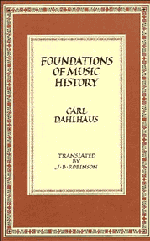Book contents
- Frontmatter
- Contents
- Translator's preface
- Foreword
- 1 Is history on the decline?
- 2 The significance of art: historical or aesthetic?
- 3 What is a fact of music history?
- 4 Does music history have a ‘subject’?
- 5 Historicism and tradition
- 6 Hermeneutics in history
- 7 The value-judgment: object or premise of history?
- 8 The ‘relative autonomy’ of music history
- 9 Thoughts on structural history
- 10 Problems in reception history
- Bibliography
- Index
8 - The ‘relative autonomy’ of music history
Published online by Cambridge University Press: 01 June 2011
- Frontmatter
- Contents
- Translator's preface
- Foreword
- 1 Is history on the decline?
- 2 The significance of art: historical or aesthetic?
- 3 What is a fact of music history?
- 4 Does music history have a ‘subject’?
- 5 Historicism and tradition
- 6 Hermeneutics in history
- 7 The value-judgment: object or premise of history?
- 8 The ‘relative autonomy’ of music history
- 9 Thoughts on structural history
- 10 Problems in reception history
- Bibliography
- Index
Summary
The ‘relative autonomy’ of art and art history is a Marxist category – but not exclusively so. Friedrich Engels used the term in his letters of the 1890s in order to protect the Marxist ‘base versus superstructure’ schema from charges of philistinism by conceding primacy to economic considerations only as a ‘last resort’. Yet even within Marxism itself, or among those authors who wish to pass for Marxists, the precise meaning of the autonomy principle is by no means clear, and the function that attaches to it changes with the polemical currents of the age.
Nowadays no-one even remotedly familiar with the discussions of aesthetic autonomy would dispute the proposition that it is not a principle divorced from and lording over history so much as a phenomenon that has historical limitations and is subject to historical change. The problem lies in deciding on its historical scope, as this entails probing the connotations of a term which seems at times so broad as to encompass what Heinrich Besseler called ‘presentation music’ (Darbietungsmusik), as opposed to ‘everyday music’ (Umgangsmusik), and yet can be so tightly construed as to collapse into a mere equivalent of the principle of art for art's sake.
- Type
- Chapter
- Information
- Foundations of Music History , pp. 108 - 129Publisher: Cambridge University PressPrint publication year: 1983



